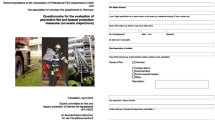Abstract
Available safety egress time under ship fire (SFAT) is critical to ship fire safety assessment, design and emergency rescue. Although it is available to determine SFAT by using fire models such as the two-zone fire model CFAST and the field model FDS, none of these models can address the uncertainties involved in the input parameters. To solve this problem, current study presents a framework of uncertainty analysis for SFAT. Firstly, a deterministic model estimating SFAT is built. The uncertainties of the input parameters are regarded as random variables with the given probability distribution functions. Subsequently, the deterministic SFAT model is employed to couple with a Monte Carlo sampling method to investigate the uncertainties of the SFAT. The Spearman’s rank-order correlation coefficient (SRCC) is used to examine the sensitivity of each input uncertainty parameter on SFAT. To illustrate the proposed approach in detail, a case study is performed. Based on the proposed approach, probability density function and cumulative density function of SFAT are obtained. Furthermore, sensitivity analysis with regard to SFAT is also conducted. The results give a high-negative correlation of SFAT and the fire growth coefficient whereas the effect of other parameters is so weak that they can be neglected.
Similar content being viewed by others
References
Au, S. K., Wang, Z. H. and Lo, S. M., 2007. Compartment fire risk analysis by advanced Monte Carlo simulation, Eng. Struct., 29(9): 2381–2390.
Cooper, L. Y., 1980. Estimating Safe Available Egress Time from Fires, NBSIR 80-2172, Washington, DC, National Bureau of Standards.
Evans, D. D. and Stroup, D. W., 1985. Methods to calculate the response time of heat and smoke detectors installed below large unobstructed ceilings, Fire Technol., 22(1): 54–65.
Holborna, P. G., Nolana, P. F. and Goltb, J., 2004. An analysis of fire sizes, fire growth rates and times between events using data from fire investigations, Fire Safety J., 39(6): 481–524.
Hostikka, S. and Keski-Rahkonen, O., 2003. Probabilistic simulation of fire scenarios, Nucl. Eng. Des., 224(3): 301–311.
IMO Maritime Safety Committee, 1997. Interim Guide1ines for the App1ication formal Safety Assessment (FSA) to the IMO Rule-Making Process, MSC/Circ.829 and MEPC/Circ.335, IMO.
International Maritime Organization (IMO), 2008. International Convention for the Safety of Life at Sea, MSC. London, 258 (84), IMO.
International Organization for Standardization, 1999. ISO/TR 13387-2: 1999(E): Fire Safety Engineering - Part 2: Design Fire Scenarios and Design Fires, Geneva, Switzerland.
Janssens, M. L., 2000. An Introduction to Mathematical Fire Modeling, Technomic Publishing Company, Inc. Pennsylvania.
Joglar, F., Mowrer, F. and Modarres, M., 2005. A probabilistic model for fire detection with applications, Fire Technol., 41(3): 151–172.
Kathy, A., 2000. The Role of Uncertainty in Improving Fire Protection Regulation, Ph.D. Thesis, Carnegie Mellon University.
Lundin, J., 2005a. On quantification of error and uncertainty in two-zone models used in fire safety design, J. Fire Sci., 23(4): 329–354.
Lundin, J., 2005b. Quantifying error and uncertainty in CFAST 2.0 temperature predictions, J. Fire Sci., 23(5): 365–388.
McGrattan, K. B., 2006. Fire Dynamics Simulator (Version 4): Technical Reference Guide, National Institute of Standards and Technology, MD, Gaithersburg, Special Publication 1018.
Notarianni, K. A., 2002. Uncertainty, SFPE Handbook of Fire Protection Engineering, Third edition, Quincy, Massachusetts, National Fire Protection Association, Section Five, Chapter 4: 5-40–5-63.
Peacock, R. D., Reneke, P. A., Averill, J. D. et al., 2000. A User’s Guide for CFAST: An Engineering Tools for Estimating Fire Growth and Smoke Transport, 2000 Edition, Special Publication 924, Gaithersburg BRFL, National Institute of Standards and Technology.
Saltelli, A., Tarantola, S., Campolongo, F. et al., 2004. Sensitivity Analysis in Practic: A Guide to Assessing Scientific Models, John Wiley & Sons publishers.
Tewarson, A., 2004. Combustion efficiency and its radiative component, Fire Safety J., 39(2): 131–141.
Upadhyay, R. R. and Ezekoye, O. A., 2008. Treatment of design fire uncertainty using quadrature method of moments, Fire Safety J., 43(2): 127–139.
Walton, W. D., 1985. ASET-B: A room fire program for personal computers, Fire Technology, 21(4): 293–309.
Yuen, W. W. and Chow, W. K., 2005. A Monte Carlo approach for the layout design of thermal fire detection system, Fire Technol., 41(2): 93–104.
Zou, G. W., Liu, S. L., Zhou Y. J. and Hao, Z., 2004. Survey of ship engine-room fire in China, China Safety Science Journal, 14(5): 76–79. (in Chinese)
Zukoski, E. E., Kubota, T. and Cetegen, B., 1980. Entrainment in fire plumes, Fire Safety J., 3(3): 107–121.
Author information
Authors and Affiliations
Corresponding author
Additional information
This work was financially supported by the National Natural Science Foundation of China (Grant No. 50909058), “Chen Guang” Project of Shanghai Municipal Education Commission and Shanghai Education Development Foundation Science & Technology (Grant No. 10CG51), and the Innovation Program of Shanghai Municipal Education Commission (Grant No.11YZ133).
Rights and permissions
About this article
Cite this article
Wang, Jh., Chu, Gq. & Li, Ky. Study on the uncertainty of the available time under ship fire based on Monte Carlo sampling method. China Ocean Eng 27, 131–140 (2013). https://doi.org/10.1007/s13344-013-0012-1
Received:
Revised:
Accepted:
Published:
Issue Date:
DOI: https://doi.org/10.1007/s13344-013-0012-1




